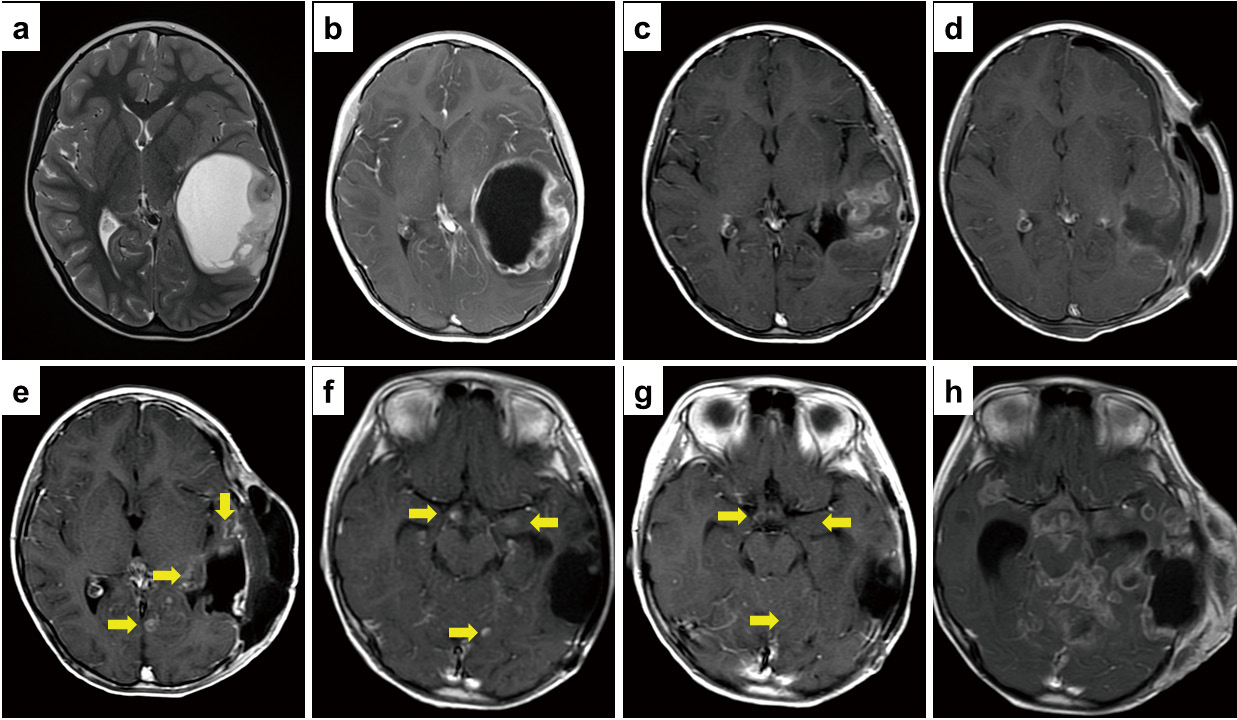- 著者
- Kentaro CHIBA Yasuo AIHARA Yuichi ODA Kenta MASUI Takashi KOMORI Hideaki YOKOO Takakazu KAWAMATA
- 出版者
- The Japan Neurosurgical Society
- 雑誌
- NMC Case Report Journal (ISSN:21884226)
- 巻号頁・発行日
- vol.10, pp.265-271, 2023-12-31 (Released:2023-10-14)
- 参考文献数
- 32
Extracranial brain tumor metastases are extremely rare. The etiology, pathophysiology, and clinical progression of systemic metastatic brain cancer remain to be elucidated. We encountered a case of pediatric diffuse high-grade astrocytoma in a four-year-old girl with subcutaneous and lymph node metastases. Numerous metastatic lesions emerged, progressed rapidly, and were difficult to manage despite temozolomide (TMZ) administration. The patient underwent repeated surgical resection for these lesions. Conversely, the primary intracranial lesions responded well to TMZ for some time. However, the patient died 15 months after the initial diagnosis. Extracranial metastasis and highly varying effects of chemotherapy were the characteristic clinical features in this case. Our analysis did not reveal definitive histopathological and molecular factors contributing to this presentation. The lack of notable molecular pathological features illustrates the unpredictability of glioma metastasis, and the treatment for extracranial metastasis remains unknown. A gene panel analysis revealed several genetic aberrations, including PDGFRA, PIK3CA, and NBN mutations. As it is impossible to resect all frequently and rapidly progressing lesions, we stress that the prognosis of metastatic brain tumors is undoubtedly poor if these tumors are refractory to existing treatments, including chemotherapy.
- 著者
- Minami SASAKI Seiichiro HIRONO Yue GAO Izumi SUDA Tomoo MATSUTANI Masayuki OTA Takashi KISHIMOTO Jun-Ichiro IKEDA Hideaki YOKOO Yasuo IWADATE
- 出版者
- The Japan Neurosurgical Society
- 雑誌
- NMC Case Report Journal (ISSN:21884226)
- 巻号頁・発行日
- vol.9, pp.101-109, 2022-12-31 (Released:2022-05-18)
- 参考文献数
- 29
- 被引用文献数
- 3
Intracranial myxoid mesenchymal tumors (IMMTs) with EWSR1-CREB1 family gene fusion are rare brain neoplasms characterized by gene fusion between the EWSR1 gene and one of the cyclic AMP response element-binding (CREB) family transcription factor (CREB1, ATF1, or CREM) genes. Although half of reported cases are pediatric, the clinical, histologic, and genomic features of IMMTs with EWSR1 rearrangement in pediatric populations are not yet well clarified. Here we describe the case of a 7-year-old girl who presented with seizures due to an extra-axial tumor in the left parietal convexity. Gross total resection was achieved, and the tumor displayed a multilobular structure with solid hypercellular and myxoid hypocellular areas, separated by a variable amount of stroma. The hypercellular areas consisted of round to polygonal cells, whereas the myxoid areas were ovoid to spindled cells. Immunophenotypically, the tumor cells were positive for vimentin, desmin, and EMA. Next-generation sequencing of tumoral DNA revealed EWSR1-CREM gene fusion and a pathogenic mutation of MAP3K13. No recurrence was detected 9 months after resection, without chemotherapy or radiotherapy. In comparison to other pediatric and adult patients with EWSR1 rearrangement, many clinical, radiological, and immunohistochemical features were shared. However, signs of elevated intracranial pressure were more frequently observed, and postoperative radiation was less frequently administered for pediatric patients. Gross total resection (GTR) was the key prognostic factor for better disease control especially among pediatric patients. Further reports of cases with EWSR1 rearrangement with detailed genetic profiles are essential for clarifying the oncogenic pathway and establishing a standard treatment strategy.
